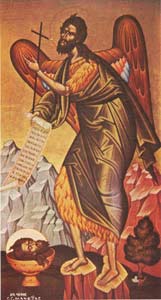August 29
St. John the Baptizer was the last of the prophets, uniting the Old and the New Testaments. On August 29th is celebrated the last major feast of the church year, the martyrdom of John at the hands of Herod Antipas. John had condemned the marriage of Herod to Herodias, the wife of his half-brother. The Gospel of Matthew records the beheading of John at the request of the young daughter of Herodias, and the Roman historian Josephus also relates how Herod ordered his death because of his great popularity and the King’s fear of an uprising of the people.
Celebration of the feast of the Beheading of John the Baptist dates to the fourth century A.D., correlating to the first finding of his head. Following his martyrdom, his disciples took and buried his body, but his head, which had been irreverently discarded by Herodias, was secretly taken by the venerable Joanna and buried on the Mount of Olives, where it remained forgotten for centuries. During the reign of Constantine the Great, John appeared to two monks in a dream and revealed the location of his head. It was unearthed, but later hidden and lost again.
It was discovered again in 452 A.D., again thanks to John appearing in a dream, and this time transferred to Constantinople. During the Iconoclastic wars of the 8th century it was hidden in Comana of Asia Minor, where John Chrysostom had died. It was discovered for the third time in 857 during the reign of Emperor Michael. Finally, during the Fourth Crusade (1204 A.D.) It disappeared, allegedly taken by crusaders to the West. At the present time several churches claim its possession, as do Muslims, who also honor John as a prophet and believe that his head is interred at the Umayyad Mosque in Damascus, Syria.
